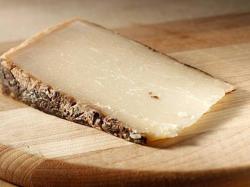Grape Skins Coat Capra Ubriaco
April 12, 2010 | 2 min to read

History has forgotten the names of the cheesemakers who developed many of the techniques still in use today. We'll never know, for example, which clever or desperate producer first thought to bury wheels in grape must — probably to hide them from marauding soldiers or the tax collector — but the practice endures in northeastern Italy at the family-owned Perenzin creamery.
The Perenzin's Capra Ubriaco al Traminer spends 10 days immersed in must — the fermenting juice, skins and seeds of crushed wine grapes — to re-create these furtively secreted cheeses of yesteryear. The wheels, which weigh about 15 pounds, are vacuum-packaged with some of the dried grape skins still clinging to them.
Made in the spring with pasteurized goat's milk and matured for six months before it gets its wine bath, the Capra Ubriaco comes from the province of Belluno. Piave and Montasio, both cow's milk cheeses, are also made in the vicinity, and it looks as if the same form is used to mold all three cheeses; they are virtually identical in shape and size.
I have tried this cheese twice, and the two samples were markedly different.
The first one was profoundly aromatic, with intense sour-milk smells that I found intriguing but feared would not appeal to others. Its texture was brittle and slightly granular.
The second wedge, which I much preferred, made me suspect that the first sample was not a good representation. Perhaps it had suffered in transit.
To read the rest of the story, please go to: The San Francisco Chronicle
